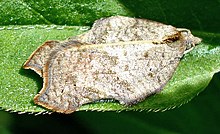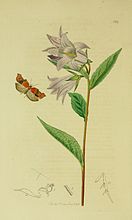Acleris emargana
| Acleris emargana | |
|---|---|

| |
| Scientific classification | |
| Domain: | Eukaryota |
| Kingdom: | Animalia |
| Phylum: | Arthropoda |
| Class: | Insecta |
| Order: | Lepidoptera |
| Family: | Tortricidae |
| Genus: | Acleris |
| Species: | A. emargana
|
| Binomial name | |
| Acleris emargana (Fabricius, 1775)
| |
| Synonyms | |
| |
Acleris emargana, the notched-winged tortricid, is a moth of the family Tortricidae.
Subspecies
- Acleris emargana emargana (Europe to Japan)
- Acleris emargana tibetica (Tibet)
Acleris emargana blackmorei, described as occurring in North America, was formerly considered a subspecies of A. emargana. Per Karsholt et al. (2005), it is now considered synonymous with Acleris effractana.[1]
Description
Acleris emargana has a wingspan of 18–22 mm. It is a quite variable species. The forewings are greyish brown or yellow ochereous, lightly translucent, usually more or less notched and hooked on the costa, with a reticulated (net-like) pattern. Hindwings are greyish and translucent. The moths are on wing from July to November and fly at dusk.
The larvae can reach a length of about 15 mm. They are pale green, with a pale brown head. Caterpillars feed on the leaves and shoots of various trees, including Alnus glutinosa, Corylus, Salix, Populus and Betula.
Distribution
The nominotypical subspecies Acleris emargana emargana is found from Europe to Siberia, northern China, Korea and Japan. In Tibet, ssp. Acleris emargana tibetica is found.
Gallery
-
Acleris emargana emargana
-
Illustration from John Curtis's British Entomology Volume 6
References
- ^ Karsholt, Ole; Aarvik, Leif; Gassiz, David; Huemer, Peter; Tuck, Kevin (2005). "Acleris effractana (Hübner, 1799) – a Holarctic Tortricid" (PDF). Nota lepidopterologica. 28 (2): 93–102. ISSN 0342-7536. Retrieved 31 March 2016.
- Ole Karsholt A Holarctic Tortricid
External links


